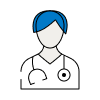The term COPD has replaced the previously separate conditions of chronic bronchitis and emphysema.
Bronchitis affects the lining of your bronchi - the main airways that lead from your windpipe (trachea) to your lungs. The lining becomes irritated and inflamed if you have chronic bronchitis and produces excess mucus that blocks the airways.
Emphysema affects your alveoli - the tiny air sacs where oxygen passes into the blood. Emphysema damages the structure of the alveoli causing the walls to break down.
The effects of COPD mean less oxygen passes into your blood.
Causes of COPD
The biggest single cause of COPD is smoking.
If you stop smoking, your chances of developing COPD begin to fall. If you already have COPD, stopping smoking can lead to an improvement in your symptoms and mean it progresses more slowly.
You are also more likely to get COPD:
- if your job exposes you to certain dusts or fumes
- from environmental factors, such as air pollution
- from inherited problems - an inherited shortage of a protein called alpha antitrypsin that helps protect your lungs from the effects of smoking may increase your risk, but fewer than one in 100 people with COPD have this
Allergies and asthma have also been suggested to increase your chances of getting COPD, but the evidence is not conclusive.
Symptoms of COPD
At first, you may not notice any symptoms of COPD. The condition progresses gradually, starting with either a phlegmy cough or breathlessness. Many people developing COPD do not see their doctor at this stage, but the earlier you get treatment the better.
As the disease progresses symptoms can vary but they include:
- chronic cough (often the first symptom)
- a gradual increase in breathlessness with physical exertion
- regularly coughing up phlegm
- wheezing
- weight loss
- waking up at night as a result of breathlessness caused by lying flat
- feeling tired
It is rare to get chest pains or cough up blood if you have COPD - if this happens you may either have a different disease or another disease as well as COPD.
You may find that your symptoms are worse in winter. It is common to have two or more flare-ups a year. This is when your symptoms are particularly severe.
Diagnosis of COPD
Your doctor will ask about your symptoms and examine you. He or she may also ask you about your medical history. If your doctor thinks you have COPD, he or she will ask you about the problems you have had with your chest and how long you have had them. He or she will usually examine your chest with a stethoscope, listening for noises such as wheezing or crackles.
Your doctor may also perform a lung test called a spirometry test. You will be asked to blow into a device that measures how much and how fast you can force air out from your lungs. Different lung problems produce different results so this test helps to separate COPD from other chest conditions such as asthma.
Other tests you might have include:
- a blood test to look for anaemia or signs of infection
- a chest X-ray to see if your lungs show signs of COPD, and to exclude other lung diseases
- a CT scan to build up a three-dimensional picture of your lungs to rule out other diseases
- an electrocardiogram (ECG) to measure the electrical impulses from your heart to check if you have heart and/or lung disease
- an echocardiogram to see if your heart is working as it should
- a pulse oximeter to monitor the oxygen concentration in your bloodstream to see if you need oxygen therapy
- an antitrypsin deficiency test - you may need this if your COPD developed when you were 40 or younger or if you don't smoke
Treatment of COPD
"There is not a cure or a way to reverse the damage to your lungs but there are things you can do to stop COPD from getting worse. The most important treatment is to stop smoking. Giving up smoking can relieve your symptoms and slow down the progression of COPD, even if you've had it for a long time. If you have mild COPD, stopping smoking may get rid of your symptoms completely.
Self-helpThere are other steps you can take to stop COPD getting worse and to ease your symptoms, including:
- keeping up your fluid levels by drinking enough water and using steam or a humidifier to help keep your airways moist - this can help reduce the thickness of mucus and phlegm that are produced
- exercising to keep moving and eating a healthy diet to help your heart and lungs
- having a flu vaccination each year, as COPD makes you particularly vulnerable to the complications of flu, such as pneumonia (bacterial infection of the lungs)
- having a vaccination for the Streptococcus pneumoniae bacterium that causes pneumonia
Pulmonary rehabilitationAsk your doctor about pulmonary rehabilitation. These are programmes consisting of exercise, education about COPD, advice on nutrition and psychological support. Pulmonary rehabilitation has been shown to help people with COPD.
MedicinesThere are various medicines that may help to ease your symptoms. Some help to control flare-ups. Discuss with your doctor which treatment is best for you.
BronchodilatorsThese treatments, commonly used for asthma, may help to relieve wheezing and breathlessness by relaxing your lungs (bronchodilation) so that air flows into them more easily. They are available as short-acting or long-acting inhalers or as tablets.
SteroidsSteroid treatments may help if you have more severe COPD. They are usually used if bronchodilators are not effective and are available as inhalers or as tablets.
Steroid tablets may be prescribed as a short course for one or two weeks if you have a bad flare-up. They work best if you take them as soon as possible after the flare-up starts.
MucolyticsMucolytics break down the phlegm in your lungs, making it easier for you to cough it up. Your doctor may prescribe you a mucolytic if you have a chronic, phlegm-producing cough. Mucolytics may also reduce the number of flare-ups you have although more research is needed to prove this.
Oxygen therapyIf your COPD becomes severe, you may develop low blood oxygen levels. Oxygen therapy can help relieve this. You inhale the oxygen through a mask or small tubes (nasal cannulae) that sit beneath your nostrils.
The oxygen is provided in large tanks for home use, or in smaller, portable versions for outside the home. An oxygen concentrator - a machine that uses air to produce a supply of oxygen-rich gas - is an alternative to tanks.
It is particularly important to give up smoking if you have oxygen therapy for COPD because there is a serious fire risk. Oxygen therapy can either be short-term, long-term - where you use it all the time at home - or ambulatory - when it's used for exercise or when outdoors.
SurgeryIf you have severe COPD, your doctor may recommend surgery to remove diseased areas of your lung. This can help your lungs to function more effectively. However, this is only carried out in certain circumstances - ask your doctor for more advice. Rarely, having a lung transplant may be an option. This is usually only if your life expectancy is under two years."
Disclaimer
This information was published by Bupa Group's Health Content Team and has been reviewed by appropriate medical or clinical professionals. To the best of their knowledge the information is current and based on reputable sources of medical evidence, however Bupa (Asia) Limited makes no representation or warranty as to the completeness or accuracy of the Content.
The information on this page, and any information on third party websites referred to on this page, is provided as a guide only. It should not be relied upon as a substitute for professional medical advice, nor is it intended to be used for medical diagnosis or treatment. Bupa (Asia) Limited is not liable for any loss or damage you suffer arising out of the use of, or reliance on, the information.
Third party websites are not owned or controlled by Bupa and any individual may be able to access and post messages on them. Bupa is not responsible for the content or availability of these third party websites. Last updated August 2017.










